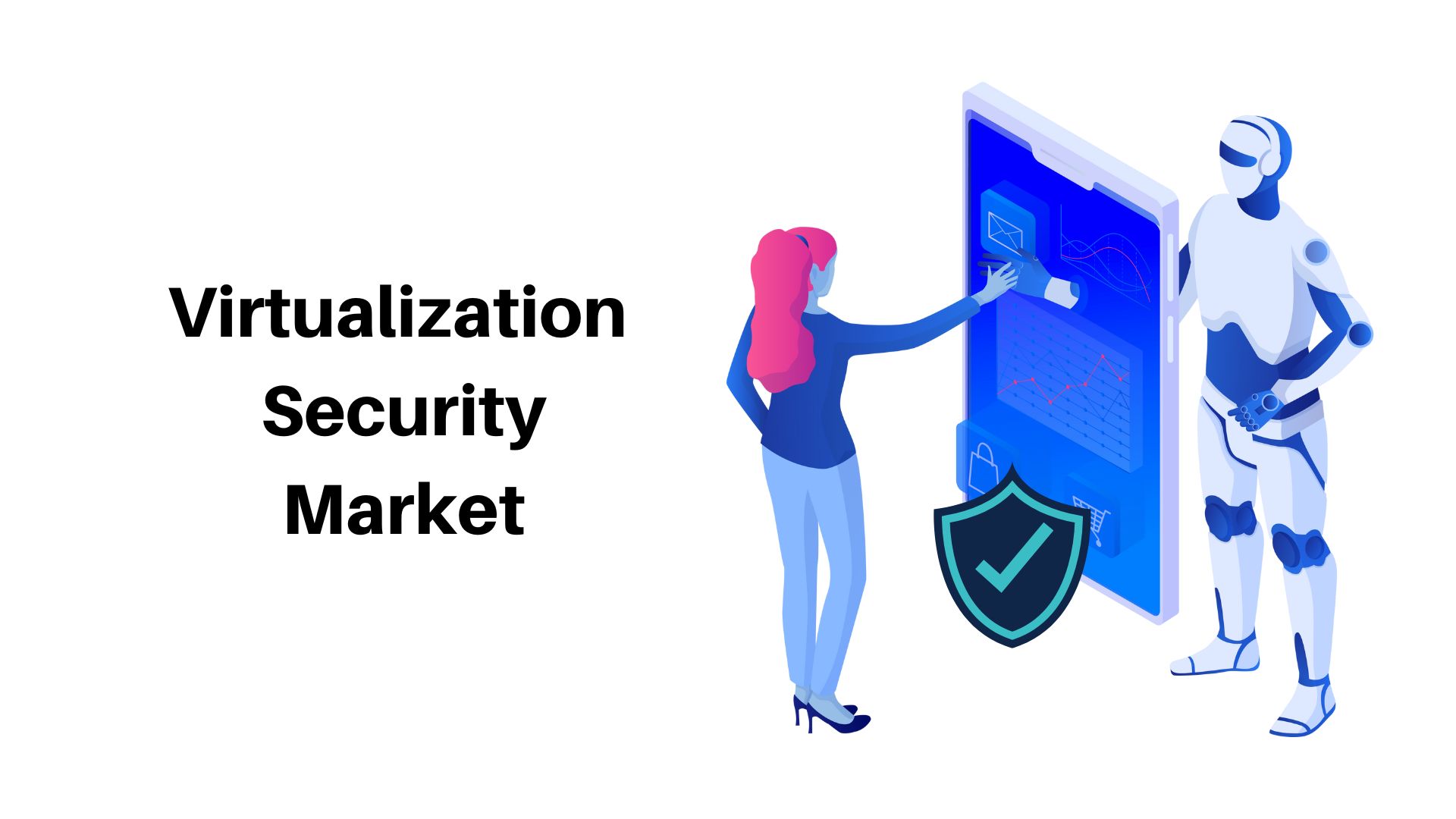Virtualization Security Market Projected To Reach USD 11.5 Bn By 2033, at a CAGR Of 15.3%

Page Contents
Market Overview
Published Via 11Press: The Virtualization Security Market is a rapidly growing segment of the broader cybersecurity industry. Virtualization refers to the process of creating a virtual version of a physical resource, such as a server, operating system, or network, using software to simulate its behavior. Virtualization is becoming increasingly popular in data centers and cloud computing environments, as it allows for more efficient use of hardware resources and enables organizations to scale their IT infrastructure quickly and easily.
Global Virtualization Security Market Value at USD 2.8 Bn In 2023 and Is Projected To Reach USD 11.5 Bn By 2033, at a CAGR Of 15.3%.
However, virtualization also introduces new security risks that must be addressed. Virtualization security involves protecting virtual machines (VMs) from attacks, ensuring the integrity and confidentiality of data stored on virtualized systems, and securing the hypervisor that manages the virtualized environment.
The virtualization security market includes a variety of vendors offering solutions such as virtual firewalls, intrusion detection and prevention systems, virtual security appliances, and security information and event management (SIEM) tools tailored specifically for virtualized environments. These solutions are designed to help organizations monitor and control access to their virtualized systems, detect and respond to security incidents, and ensure compliance with industry and government regulations.
To get additional highlights on major revenue-generating segments, Request a Virtualization Security Market sample report at https://marketresearch.biz/report/virtualization-security-market/request-sample/
Key Takeaways
- Virtualization has become an increasingly popular choice in data centers and cloud computing environments, but this also introduces additional security risks that must be managed.
- Virtualization security market vendors provide solutions such as virtual firewalls, intrusion detection and prevention systems, virtual security appliances and SIEM tools specifically tailored for virtualized environments.
- As more organizations adopt virtualization technologies and seek to secure their virtualized environments, the virtualization security market should experience substantial growth.
- VMware, Inc. is one of the key players in the virtualization security market along with Trend Micro Inc. and Fortinet Inc. Other notable names in this space include Symantec Corporation, McAfee LLC, Cisco Systems, Inc. and Check Point Software Technologies Ltd.
- Virtualization security solutions allow organizations to monitor and control access to virtualized systems, detect security incidents quickly and respond accordingly while meeting industry or government regulations.
- Virtualization security solutions are designed to safeguard virtual machines against attacks, protect data stored on virtualized systems from corruption and maintain confidentiality, as well as to secure the hypervisor that manages this environment.

Regional Snapshot
- North America is the global leader in virtualization security due to the presence of key players and early adoption of virtualization technologies within this region. In particular, the US and Canada play key roles in driving growth within this market.
- Europe is an emerging market for virtualization security due to the increasing adoption of cloud computing and virtualization technologies across the region. Countries like UK, Germany, France and Spain are major contributors to this market growth in Europe.
- Asia-Pacific region is projected to experience the fastest virtualization security market growth during its forecast period, due to increased adoption of virtualization technologies, an increase in cyber attacks, and demand for improved protection solutions.
- Middle East and Africa regions are also projected to experience rapid expansion of their virtualization security market due to increased adoption of cloud computing and virtualization technologies as well as rising needs for advanced security solutions.
- Latin America's virtualization security market is projected to experience steady expansion throughout the forecast period due to rising adoption of cloud computing and virtualization technologies as well as raising awareness of cyber security threats in the region.
Drivers
- Virtualization Technologies Are Gaining Ground: Virtualization technologies have seen rapid adoption across various industries, helping organizations save costs, enhance efficiency and expand flexibility. Yet virtualization presents its own set of security issues; hence the rise in the need for virtualization security solutions.
- Rising Number of Cyber Attacks: Cyber attacks are becoming more sophisticated and frequent, and virtualized environments are no exception to their effects. To safeguard virtualized environments against potential cyber threats, virtualization security solutions have become a necessity.
- Compliance Requirements: Organizations must abide by various regulations such as PCI DSS, HIPAA and GDPR which mandate that their virtualized environments be secured. Virtualization security solutions help ensure organizations comply with such requirements.
- Cloud Adoption Is Expanding: Cloud computing has seen steady adoption over recent years, with virtualization playing an essential role. As more organizations transition their workloads into the cloud, virtualization security solutions become an ever more critical issue.
- Virtualization Security Awareness Is Rising: Organizations and IT professionals have become more aware of virtualization security, driving up demand for solutions to protect virtualized environments.
Restraints
- Lack of Awareness: Many organizations may be unaware of the security risks associated with virtualized environments, and so fail to invest in virtualization security solutions.
- Compatibility Issues: Not all virtualization security solutions may work across platforms, which could impede their uptake and adoption.
- Implementation Costs Can Be High: Implementation costs associated with virtualization security solutions may be prohibitively high for some organizations and could dissuade them from investing in them.
Opportunities
- Cloud Computing Adoption: Cloud computing adoption has seen rapid expansion, with virtualization as an integral component. As more organizations move their workloads to the cloud, demand for virtualization security solutions increases significantly; creating an opportunity for virtualization security vendors to develop innovative solutions to address the security concerns in cloud-based virtualized environments.
- Rising Demand for Managed Security Services: Many organizations are turning to managed security service providers (MSSPs) for help with their security needs, both to reduce costs and enhance their security posture. This presents virtualization security vendors an opportunity to partner with MSSPs by offering virtualization security solutions as part of their managed security services offerings.
- Integration With DevOps and Automation: DevOps and automation have quickly become indispensable elements in IT industry, with organizations seeking security solutions that integrate into these workflows seamlessly. This presents virtualization security vendors an opportunity to develop products that seamlessly incorporate DevOps workflows.
- Emergence of Software-Defined Data Centers: Software-defined data centers (SDDCs) have become more and more prevalent, offering greater flexibility and efficiency than traditional data centers. This has given virtualization security vendors an opportunity to develop solutions to protect SDDCs against cyber attacks.
Challenges
- Complexity of Virtualized Environments: Virtualized environments can be complicated environments with multiple layers and components that must be secured; this can make implementing and managing virtualization security solutions challenging for organizations.
- Lack of Skill and Expertise: Virtualization security requires specific expertise that may not exist within all organizations. Without this specialized in-house expertise, virtualized environments may remain vulnerable.
- Integrating Legacy Systems: Many organizations rely on legacy systems that may not be compatible with virtualization security solutions, making implementation and management of such solutions challenging in these environments.
- Implementation Costs: Virtualization security solutions can be expensive to implement, especially for smaller and midsized businesses. Licensing fees, hardware purchases and personnel salaries may become significant barriers to adoption for certain organizations.
- Performance Overhead: Virtualization security solutions may incur performance overhead that adversely impacts virtualized applications and systems, creating issues for organizations relying on high-performance computing but who cannot tolerate any reduction in performance. This is of particular concern for organizations that demand high-performance computing without experiencing any degradation in performance.
Market Segmentation
By Component
- Solution
- Services
By Organization Size
- SMEs
- Large Enterprises
By Deployment Mode
- On-Premise
- Cloud
By Industry Vertical
- BFSI
- Government & Defense
- IT & Telecommunication
- Healthcare & Life Sciences
- Retail
- Manufacturing
- Education
- Other Industry Verticals
Key Players
- Trend Micro Incorporated
- IBM Corporation
- Juniper Networks, Inc.
- Dell EMC
- Intel Corporation
- Microsoft Corporation
- VMware, Inc.
- Broadcom, Inc.
- Sophos Ltd.
- McAfee, LLC
- Other Players
Report Scope
| Report Attribute | Details |
| Market size value in 2023 | USD 2.76 Bn |
| Revenue forecast by 2033 | USD 11.46 Bn |
| Growth Rate | CAGR of 15.3% |
| Regions Covered | North America, Europe, Asia Pacific, Latin America, and Middle East & Africa, and Rest of the World |
| Historical Years | 2017-2022 |
| Base Year | 2022 |
| Estimated Year | 2023 |
| Short-Term Projection Year | 2028 |
| Long-Term Projected Year | 2033 |
Recent Developments
- Trend Micro Announces Launch of Cloud One – Workload Security: In February 2021, Trend Micro launched Cloud One – Workload Security as a cloud-native security solution specifically tailored for virtualized environments and cloud instances, such as VMware or Hyper-V. It integrates seamlessly into these popular virtualization platforms like VMware or Microsoft Hyper-V for seamless protection against workload threats.
- VMware Acquires Lastline: In June 2020, VMware acquired Lastline – an AI-powered security solutions provider designed to protect networked and endpoint devices – as part of an acquisition to strengthen VMware's offerings for virtualized and cloud environments.
- Fortinet Introduces FortiGate VM-Series for Google Cloud: In March 2021, Fortinet launched their virtualized security solution FortiGate VM-Series for Google Cloud which offers advanced threat protection for workloads running in Google Cloud environments. This virtual security offering features virtual firewalls, intrusion prevention systems and VPN capabilities.
- Check Point Software Launches CloudGuard Cloud Native Security: In February 2021, Check Point Software unveiled CloudGuard Cloud Native Security as a comprehensive solution designed to offer advanced threat prevention and cloud security posture management for virtualized and cloud environments, such as VMware, Hyper-V and Nutanix virtualization platforms. The solution supports popular virtualization platforms including VMware ESXi 5.5/6/7.8.x environments.
FAQ
1. What are the components and purposes of virtualization security?
A. Virtualization security refers to the practice of protecting virtualized environments, including virtual machines (VMs), hypervisors and networks. Virtualized environments present unique security risks not present in traditional physical environments – for instance, VM escape attacks that may compromise virtual machines (VMs). It is crucial that these environments remain secure.
2. What are the key drivers of the virtualization security market?
A. Key factors driving the virtualization security market include increasing adoption of virtualization technologies, increasing cyber-attacks, need for compliance requirements, growing cloud computing adoption rates, and awareness about virtualization security issues and technological advancements.
3. What are the challenges affecting the virtualization security market?
A. Virtualization security markets face numerous hurdles, such as their complexity, limited skills and expertise, integration with legacy systems, cost of implementation, performance overhead costs and emerging threats.
4. What are the key virtualization security solutions currently available on the market?
A. Key virtualization security solutions include virtual firewalls, intrusion detection and prevention systems, virtual security appliances, Security Information and Event Management (SIEM) tools and cloud-native solutions.
5. Which regions are driving the growth of the virtualization security market?
A. North America currently dominates the virtualization security market, followed by Europe and Asia-Pacific regions; however, Asia-Pacific is expected to experience rapid expansion over the forecast period.
6. Who are the key players in the virtualization security market?
A. Key players in the virtualization security market include VMware, Inc., Trend Micro Inc., Fortinet Inc., Symantec Corp, McAfee LLC, Cisco Systems, Inc. and Check Point Software Technologies Ltd.
Contact us
Contact Person: Mr. Lawrence John
Marketresearch.Biz (Powered By Prudour Pvt. Ltd.)
Tel: +1 (347) 796-4335
Send Email: [email protected]
The team behind market.us, marketresearch.biz, market.biz and more. Our purpose is to keep our customers ahead of the game with regard to the markets. They may fluctuate up or down, but we will help you to stay ahead of the curve in these market fluctuations. Our consistent growth and ability to deliver in-depth analyses and market insight has engaged genuine market players. They have faith in us to offer the data and information they require to make balanced and decisive marketing decisions.



